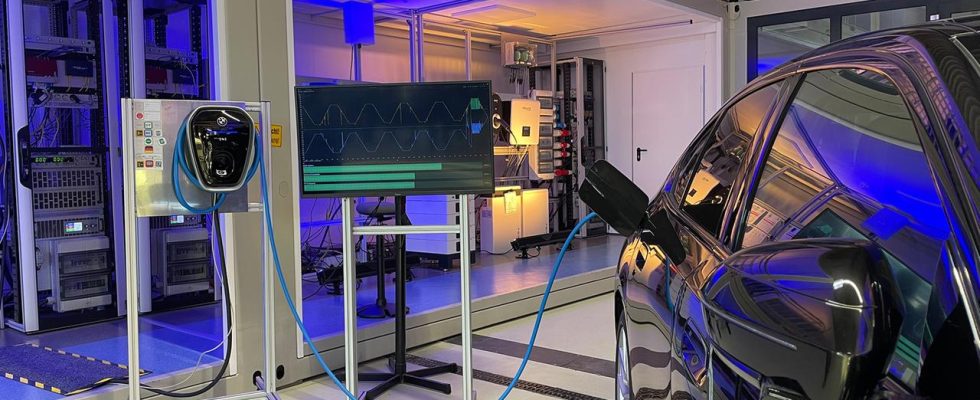Manufacturers have many innovative ideas for charging electric cars. It should be uncomplicated and integrated into intelligent systems. E.ON is now testing new solutions in its innovation center.
The display on the outside of the large cooling chamber shows minus 33 degrees. There is a charging station for electric vehicles inside. E.ON is testing how charging works at extreme temperatures. It is one of a total of 25 test stations in the new test and innovation center for electromobility in Essen. The energy company, which does not produce any charging infrastructure itself but operates thousands of charging points in Europe, wants to test the hardware of its partner companies here and work on innovative charging solutions.
In another corner of the approximately 10,000 square meter test hall there is an electric car with a charging cable in it. In this case, however, electricity does not go into the vehicle, but rather electricity flows out and, for example, supplies a hot drinks maker. “Bidirectional charging is certainly the next big thing in terms of charging infrastructure,” explains Mathias Wiecher from E.ON.
Test under extreme conditions: How does the charging process work at low temperatures?
focus is on bidirectional Load
The electric car becomes, so to speak, an energy storage device for the house. For example, if a photovoltaic system on the roof produces electricity when the sun is shining, but it is not being used in the house at that moment, it can be temporarily stored in the car battery and fed back into the house circuit later if necessary. “The technology in the vehicles and the infrastructure will probably be ready for this from 2025. However, the legislation in Germany is lagging behind,” says Wiecher.
In a few years it should also be possible for electric cars to feed excess electricity into the local energy grid. E-cars would therefore be a flexible storage option in the entire German electricity system, which will soon be subject to significantly more fluctuations due to the switch to renewable energies.
The unidirectional – i.e. simple – charging of electric cars can also be a big lever, explains Matthias Kühnbach from the Fraunhofer Institute for Solar Energy Systems. He is researching how electric cars can be used so that they can serve the electricity system and at the same time meet all of the drivers’ mobility needs. Intelligent energy management systems that are linked to the wallbox at home are required for this.
E-cars as flexible energy storage devices
In such a system, a driver can, for example, state that the electric car will not be needed the next day. “Then, charging is not carried out in the evening, when everyone tends to consume electricity, but this charging process is postponed until there is a lot of energy in the electricity market and prices are low,” says Kühnbach.
The challenge with such intelligent charging is communication between the different devices. The vehicle has to communicate with the charging station and it needs external information about the amount of electricity available on the market. There are also test setups for this in the E.ON test center.
A few meters away, dozens of wall boxes hang on a wall. They are all from different manufacturers and have different properties. The manufacturer Compleo is testing one of its devices here, which is said to offer particularly high charging performance and therefore fast charging. “We want to be 100% sure that we only sell the device if it not only works reliably. We also want to make sure that it is user-friendly,” says Jörg Lohr from Compleo.
The charging of the future is being researched in E.ON’s new innovation center.
It just has to be
The charging infrastructure manufacturer from Dortmund is constantly developing new products for the market, says Lohr: “When we talk about innovation in the area of charging infrastructure, our strategy is not to invent the next killer feature and to create even better, even more beautiful and even larger infrastructure but to advance the simplicity of the charging process.”
“Plug-and-charge” is a crucial keyword in the industry. With this system, customers will soon be able to charge at public charging stations much more easily – without payment cards, without complex authentication, and with automatic billing. When the cable is plugged in, the charging station records all the necessary information about the vehicle.
There is already a corresponding international standard for this. “This just needs to be consistently implemented in the industry,” warns Lohr. In his view, complicated charging and opaque payment structures are still the biggest obstacle to the mass acceptance of e-mobility.

